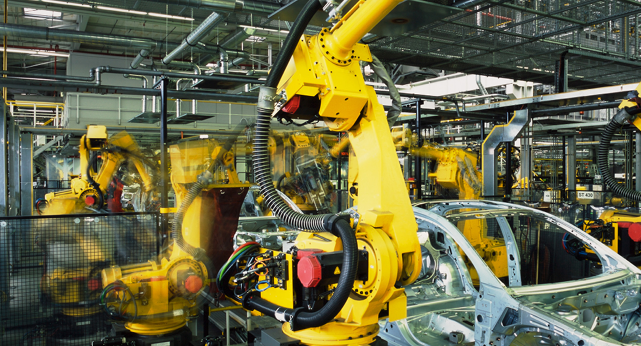
Comparing Flexible vs. Hard Automation for Manufacturing
Automotive manufacturing gets more complex by the day. The OEMs and Tier 1 part suppliers who support the industry must keep pace with the changes, and they’ve turned to automated systems to do it.
But even the field of automated manufacturing is evolving. Part producers hoping to stay competitive rely on having the right mix of fixed and flexible automation systems integrated within their works.
Choosing flexible vs. hard automation systems is about understanding the types and volumes of parts your customer requires and then matching those requirements to the appropriate manufacturing process.
Use cases for flexible automation
Flexible automation systems feature base machines designed to accept interchangeable tooling. This allows for the seamless, speedy manufacture of parts similar enough that only minor tooling changes need to be made without affecting the machine in any other way.
For example, automotive suppliers often make similar parts across a make’s lineup. In instances where the minor differences among those parts can be overcome with a tooling change and nothing more, a flexible automation system makes sense.
Another example is the frequent (though usually minor) changes to some automotive parts from model year to model year. If manufacturers and their customers recognize that these minor changes can be accomplished with updated tooling on a flexible automation setup, costs and project timelines can be reduced.
Finally, flexible automation is a good fit for operations with high product variation with abbreviated timelines when downtime due to equipment change-outs is a luxury they can’t afford.
If you’re searching for more cost savings, look for opportunities to collaborate with the OEM or Tier 1 partners to see if they can design with flexible automation systems in mind.
Cost considerations for flexible automation systems
Regardless of whether an automated system is hard or flexible, the up-front investment is significant. It’s the base machine that’s most expensive to build.
But when flexible automation systems are matched with appropriate manufacturing processes, steep up-front costs are overcome. Here’s how:
- Flexible automation eliminates some of the cost redundancies associated with buying, operating and maintaining multiple fixed systems. They also maximize throughput —and therefore revenue— relative to square footage of floor space.
- Implementing flexible automation ahead of time in anticipation of a potential design variation is always cheaper than doing it later. It reduces downtime and eliminates surprises, too.
- Flexible systems can help secure future business signaling to customers you’re prepared today for the demands of tomorrow.
The key is appropriately matching processes with a flexible automation system. Consult your automation partner and your customers to help develop the flexible automation system tailored to your unique needs.
Example of flexible automation at work
Case in point: Arnold Machine developed a flexible robotic spray machine that applies an adhesive coating on multiple parts within a single dimensional window. Its robot is programmed to perform a custom spray pattern according to each variation of part our customer planned to run through the system.
Our team designed the machine to seamlessly switch from one part to the next. An operator simply selects a part on the machine’s HMI screen to make the adjustment.
Right-fit processes for hard automation
We discuss above that flexible automation systems help manufacturers overcome challenges associated with the ways some of the parts they make are evolving. But that evolution isn’t universal. Some parts and processes don’t change that much. When that’s the case, a hard automation system might make the most sense.
For instance, some automotive parts (like oil pans or gears, for example) stay the same for years before they’re redesigned. In such a scenario, hard automation is preferred. In these systems, it’s all about long-term repeatability and quality. No retooling, no constant redesign. When parts go unchanged across multiple models over long periods of time, it’s an opportunity to secure long-term cost stability.
Hard automation is also a good fit when parts are so unique or so complex that it only makes sense for a one-off custom machine to perform a process.

Understand overall equipment effectiveness (OEE) to enhance production planning
OEMs and Tier 1 suppliers use this critical metric to judge a system’s productivity. It should be specified before any of your equipment is sourced so you can inform your automation partner which OEE goals an automation system will need to meet.
The following factors combine to demonstrate OEE:
- System availability, which measures whether your system meets its planned production timeline by accounting for planned and unplanned work stoppages.
- System quality, which measures how consistently your system performs without part defects or reworks.
- Performance rating, which measures whether your process is running at optimum efficiency.
- Achieve balance in fixed vs. flexible automation
A host of variables dictate whether manufacturing processes should be hard- or flexibly-equipped. Project managers should think in terms of balance, knowing that in most automotive manufacturing settings, both types of automated systems are used. The art is in implementing the right mix that keeps your processes cost-effective and adaptable at the same time.
Arnold Machine uses its expertise in both fixed and flexible automation systems to guide OEMs and Tier 1 suppliers toward achieving the balance that enhances the quality and efficiency of automotive manufacturing. You can learn more about it in our guide to time and cost savings in manufacturing. If you have specific questions about how to integrate flexible or fixed systems into your process, contact our team.
